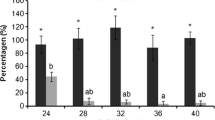Abstract
Oospore germination occurred over a temperature ranging of 15–35°C forPythium coloratum, 10–35°C forP. diclinum, 15–30°C forP. dissotocum, 7–30°C forP. monospermum, and 10–30°C forP. pleroticum. Optimum temperature was 25°C for all species tested. In case of pH, oospore germination occurred over a range of 4.76–8.55 with an optimum of 6.40–7.40. The least germination occurred at pH 4.76 forP. coloratum, P. diclinum, P. monospermum andP. pleroticum, whileP. dissotocum germinated from pH 5.02. Oospores of the all tested pythia were able to germinate at −0.13 to −1.65 MPa and could not germinate at −3.40 MPa, with the highest germination rate at −0.27 to −0.47 MPa. The effect of temperature, pH and osmotic potential on oospore germination was discussed in relation to pollution of pond water.
Similar content being viewed by others
Literature cited
Abdelzaher, H. M. A., Ichitani, T. and Elnaghy, M. A. 1993. Effect of temperature, hydrogen-ion concentration and osmotic potential on oospore germination of five aquaticPythium spp. Trans. Nishi-Nippon Div. (Mycol. Soc. Japan). p. 3.
Ayers, W. A. 1975. Factors affecting production and germination of oospores of threePythium species. Phytopathology65: 1094–1100.
Harvey, J. V. 1952. Relationship of aquatic fungi to water pollution. Sewage and Industrial Wastes24: 1159–1164.
Inoue, M. and Ichitani, T. 1990. Optimum pH range for mycelial growth ofPythium spp. estimated by MES [2-(N-morpholino) ethanesulfonic acid] buffer. Trans. Mycol. Soc. Japan31: 191–196.
Kusunoki, M. and Ichitani, T. 1982. Preparation of myceliumfree oospores ofPythium butleri by a freezing method. Ann. Phytopath. Soc. Japan48: 695–698.
Ge, L. P. and Ichitani, T. 1992. Influence of temperature, hydrogen-ion concentration and osmotic potential on oospore germination ofPythium paddicum andP. iwayamai. Bull. Univ. Osaka Pref. Ser. B44: 7–11.
Peter, B. A. 1971.Pythium aphanidermatum oospore germination as affected by time, temperature, and pH. Phytopathology61: 1149–1150.
Robinson, R. A. and Stokes, R. H. 1949. Tables of osmotic and activity coefficients of electrolytes in aqueous solution at 25°C. Trans. Faraday Soc.45: 612–624.
Stanghellini, M. E. and Burr, T. J. 1973. Effect of soil water potential on disease incidence and oospore germination ofPythium aphanidermatum. Phytopathology63: 1496–1498.
Stanghellini, M. E. and Russel, J. D. 1973. Germination in vitro ofPythium aphanidermatum oospores. Phytopathology63: 133–137.
Thill, D. C., Schirman, R. D. and Appleby, A. P. 1979. Osmotic stability of mannitol and polyethylene glycol 20,000 solutions used as seed germination media. Agronomy Journal71: 105–108.
Webster, J. 1991. “Introduction to Fungi, 2nd ed.,” Cambridge University Press, Cambridge. 169p.
Author information
Authors and Affiliations
About this article
Cite this article
Abdelzaher, H.M.A., Ichitani, T. & Elnaghy, M.A. Effect of temperature, hydrogen ion concentration and osmotic potential on oospore germination of fivePythium spp. isolated from pond water. Mycoscience 35, 315–318 (1994). https://doi.org/10.1007/BF02268500
Accepted:
Issue Date:
DOI: https://doi.org/10.1007/BF02268500



